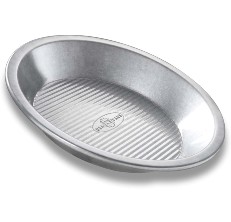
Oxo Glass Pie Plate
| Pros | Cons |
|---|---|
|
|
Our content is meticulously curated through independent research, testing, reviews, and AI-driven recommendations, all designed to present you with the finest product choices. When you make a purchase through our links, it could result in us earning a commission.

Pie pans are essential tools for crafting
delectable pies, whether you're a seasoned pastry pro or a budding
baking enthusiast. They house everything from classic apple pies to savory quiches and everything in between! In this guide, we'll dive into the best pie pans of 2024,
exploring their materials, designs, and performance. For a unique style with a convenient lid, check out our number one pick from OXO. This glass pan is a durable vessel for your pies, ensuring a comfortable grip and high-temperature resistance. Read on to find the right pie pan to elevate your baking endeavours!
Here’s a complete buyer’s guide to adding the perfect pie pan to your kitchen.
Here are a few considerations to keep in mind when buying a pie dish.
Typically, pie pans come with a diameter of 9 or 10 inches. This is considered the standard size for pies and pie dishes. As for the depth, a 2-inch deep pie pan is ideal for baking single and double-crust pies with a generous amount of filling. However, 1.5-inch deep pans can also work for double and single-crust pies. If you’re aiming for a nicer presentation and aesthetic, you can go for mini pie pans as well that make up single servings to avoid creating a mess once you cut them.
The most important consideration is the material your pie pan is made from. Pie pans come in metal, ceramic, glass, steel, porcelain, and cast iron. Each of these materials comes with its pros and cons. Ceramic pans can hold heat longer, are well-insulated for it, and bake evenly cooked and colored pies. A glass pie pan will let you see through and monitor the progress as it bakes to avoid over or underbaking accidents. Metal pie pans are best at conducting heat thoroughly and quickly. They are also inexpensive and can give you beautiful brown crusts. The heavier the metal is, the lesser chances there are that it’ll warp. Pie pans made out of aluminum are a good choice for gifting and freezing pies. They make great single-use, disposable pans.
The pie pan you get should be easy to clean and handle. You can simply look for a pie pan that can be put in a dishwasher to save time and energy of hand washing it after every use.
Pies are meant to be served in the pan they’re baked in. This is why it is important to pick a pan that looks as great as it bakes. You can choose from different colors and designs. You can also go for pans that come with a good non-stick coating or have a removable bottom. This kind helps bake tarts as they aren’t served right through the pan.
Versatile additional features that can make your pie-baking experience better should always be considered. You can consider a freezer-safe pan to prepare pies ahead. Or go for a microwave-safe pan so you can reheat the leftovers whenever you like. Pans with lids are also a convenient option for handling leftovers. You can also get a pan with crimped or ruffled edges to give your pies a little more design.
Let’s take a look at the three most common pie pan materials in detail to decide the kind that suits your baking needs the best:
Metal pie pans are ideal for golden, flaky, and crispy crusts. They are usually made from aluminum and will heat and cool down very quickly. Speedy heat conduction works in favor of recipes that demand blind baking. Metal pie plates can also bake crisp cookie crusts. However, this material is not great for baking pies that require a long baking time, such as double-crust pies as they heat up super quickly. Some metal pie tins also have a non-stick coating that can help in an easier release.
Ceramic pie pans are the most presentable of all with their colors and shapes. Ceramic pans heat up slower than metal and glass but they can retain heat well. Ceramic pans are usually large and deep in comparison to glass and metal. They’re not ideal for achieving golden flaky crusts but are best for recipes with long bake times. They are safe for freezers, microwaves, and ovens, and can handle temperature fluctuations well.
The biggest advantage of glass pans is that you can monitor the doneness of the crust. Glass heats up evenly and gently and gives a slow, consistent bake to the pie. This material is inexpensive and lightweight. Glass pie plates are constructed from borosilicate or tempered glass, among which the former is sturdier. They are not great at handling temperature fluctuations and can easily shatter in such situations.
Here are a few simple steps:
Fluted pie pans are slope-sided, shallow, and round dishes with a fluted rim. Here’s how to use it:

| Pros | Cons |
|---|---|
|
|

| Pros | Cons |
|---|---|
|
|

| Pros | Cons |
|---|---|
|
|

| Pros | Cons |
|---|---|
|
|

| Pros | Cons |
|---|---|
|
|